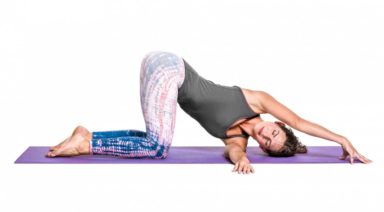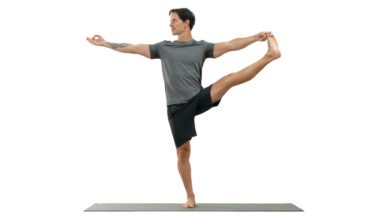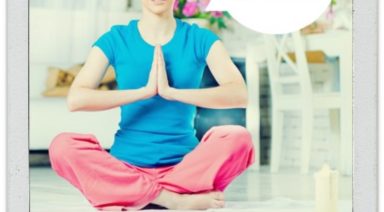How to Create a Yoga Space at Home

Yoga has been a vital practice for ages, assisting with overall health and mindfulness. It doesn’t take much work to transform an area of your home into the perfect yoga zone. All you really need is a mat and enough room to move around 360 degrees. Creating your own inviting and intimate yoga space will amp up your practice and zen mindset a hundredfold!
Having a peaceful space to practice yoga is beneficial to your overall health. It dissolves the stress from a long day at the office and helps you forget about the fact that you spend about 38 hours a year stuck in traffic. Ditch the laundry piles. Clean out that old office you never use. Get ready to transform your space and your life.
You Need a Suitable Mat and Comfortable Clothing
Cotton or other natural fiber clothes are preferable for their ability to “breathe” and flow with your body. Choose yoga pants or other relatively loose-fitting pants. You need to see the alignment of your body. You don’t want your clothes to restrict your movements, and you don’t want to trip over your pants, either. Bare feet, or socks that have a grip, are also preferable to tennis shoes or regular slippery socks.
Consider the Floor and Balance
It’s much easier to practice on a hardwood or tiled floor than a carpet. You can hold your poses with a sustained balance on a more even surface. Using a hardwood floor also reinforces your connection with the element of Earth. No matter what floor you choose, use a thick yoga mat with good traction for your feet and pick a mat that matches your style.
The Space Should be in a Low Traffic Area
This space needs to be an area that helps members of your family to respect your privacy during your practice, especially if you are not able to dedicate a room to yoga. Choose a quiet part of your home such as the attic or corner of your bedroom.
Some people find more stillness in chaos. If you’re more still with a cat climbing your back, or you like to practice with your family, then let the chaos be your calm.
Light Should Enhance the Mood of Your Yoga Space
Lighting should be calming and soft. A room with natural light energizes the body and mind, especially in winter, when many people lose Vitamin D by staying indoors. Sheer curtains in a serene blue or green may be added to reduce strong light and enhance the atmosphere of the room. You’ll want to be able to control the flow and gradation of light to match your mood. Consider the use of candles or incandescent lighting, which are less harsh on the eyes. Do not underestimate lighting! It has a profound effect on your mood and your health.
The Room Should Be Comfortable
You’ll want a warm room since yoga tends to slow down your metabolism. This makes you more prone to shivering, and shivering during a pose is not very zen. Though “hot” yoga, which sweats out toxins, utilizes a more sweltering temperature, even gentle yoga needs warmth. Consider a personal electric heater, with minimal sound distraction, for better temperature control and to avoid fuss among family members.
Sound In Your Space Should Soothe
Many practitioners prefer the sounds of nature, drums, or Eastern-influenced music. Some choose Classical scores that are simple in tune. Choose music that has a consistent rhythm that will flow well with your poses. The mood of the music should enhance your spiritual mindset. Avoid music associated with hard endurance exercises, such as pop or rock.
If using a CD or DVD player, move it to a part of the room where the sound is evenly distributed and not distracting. If creating a playlist, arrange it so that each song flows into the next.
If you have loud roommates or street noise, you will want to have space that avoids or minimizes these distractions. Turn off phones, alarms, and other noise-makers.
Scent In Your Space Should Enhance the Mood
You need the space to be clean but not smell like chemicals. Many practitioners like to smudge sage or use incense, but the accumulation of smoke may be an issue. Be sure the smoke has room to flow freely and will not set off a smoke detector. A diffuser with a blend of essential oils may be more subtle for space and easier to switch up. If you use candles, match the scent to the mood or theme of your space. Pine, for example, helps you imagine that you are practicing yoga in the forest.
Find a Focal Point
It’s easier to breathe into a focused area than it is a blank wall. Choose a statue of Buddha, a painting of a lotus flower, or other personal objects to capture your focus. You’ll want to consider multiple focal points as you transition between poses. If dedicating a room for your practice, consider decorating the walls of your space in association with the north, south, east, and west.
Avoid Creating a Busy Space
Too many objects in your space will serve as a distraction and limit your movement. Too little in a space can lead to restlessness. Be careful not to use too many bold colors. Stay with calming blue and earth tones with wall paint and decorations. Too many patterns distract the eyes and the mind.
We all have different definitions of business. Go with what makes you the most comfortable while considering the function of the space. Keeping your space simple will lead to less clutter. You don’t want to think of your yoga space as a chore.
Think of the Objects You Will Use
This also helps you avoid clutter as you personalize your practice space. For those dependent on yoga videos, this is a great time to repurpose an older television. Add plants to the room to achieve mindfulness, circulate oxygen and cleanse toxins from the air, while assisting you with connecting to the Earth.
Use comfortable pillows as perfect yoga props and cushions to sit on while meditating. Adding a pillow under your tush isn’t cheating! It helps align your back and focus your breathing.
When you have objects with multiple functions in a yoga space, you have less fuss and more function. This also means less to clean.
Where is Your Space?
Now that you have considered the atmosphere of the space and how your needs match its function, consider whether your space is a whole room or a corner of a room. Keep in mind that your feet need a steady surface and that you will probably want a wall for inversions. The length and width of your yoga mat is the perfect area, too. The space doesn’t need to be grand, as long as it serves your needs.
Turn a Goal Into a Short Mantra
“To reach a place of stillness within” becomes “I am still.” “To release daily stress and anxiety” becomes “I become calm, and calm becomes me.” These mantras are the perfect element for a meditation ritual before you begin your yoga practice.
All That’s Left Is to Set Up Your Space
Trust yourself. You know where everything goes. Each item needs to match the intention of the space. It’s about how it flows!
Your space should match its function, but it should also be one that you will dedicate yourself to. You don’t want a space so big that you can’t take care of it, because you are really focusing on taking care of yourself here. Will you clean it? Honestly? The yoga space should match your needs.
Yoga shows everyone, no matter what your spaces are, that all areas of life are worth consideration and connection. All rooms of the house and all rooms of the soul are sacred. These are spaces from which you observe the world and the self, no matter what you’re feeling or what you’re going through — be it sorrow, joy, regret, confusion, or clarity.
When you can’t make it to the studio, the studio comes to you in the form of your own yoga space.
You control the pace. You’re not rushed. You go with the flow instead of against it. Remember that this space is all yours. When you take time to create a dedicated yoga space, your practice is enhanced and your yoga experience becomes more fulfilling. Calm is only a few breaths and steps away.
5 Simple Morning Rituals to Uplift Your Mind, Body and Spirit

“Each night, when I go to sleep, I die. And the next morning, when I wake up, I am reborn.”
— Mahatma Gandhi
The subtle beauty that occurs each morning, as the earth transitions from darkness to light, is so often filled with dread or, at the very least, busyness and rushing that we miss it altogether. According to the science of Ayurveda, by waking up at one and a half hours, or at least twenty minutes, before the sun rises, you experience “special energy in the air.” This special energy makes it easier to get out of bed, as opposed to waiting until after the sun rises, which can make you feel lethargic or, as many of us have experienced, irritable and anxious. This pre-sunrise time, which is referred to as Brahma-muhurata (“the time of Brahma”), is said to be when “hope, inspiration, and peace” are manifested in the universe.
With the universe calm and your mind fresh, you can leverage this additional time for yourself, allowing it to be hugely beneficial not just for your physical body, but for your emotional and spiritual well-being too.
Because we’re so accustomed to our daily schedules, following the same routine every day as we prepare for work or help to get kids ready for school, carving out extra time each morning simply to care for yourself can feel groundbreaking. For most people, these additional twenty minutes can feel almost like two hours, especially when they spent wisely. And, even when you’re “doing things” that very well could be considered just same-old-same-old parts of the day, by approaching them to be mindful, that they are something more, something special, you begin to unveil a whole new world, one where everything starts to be steeped in magic.




































